NVIDIA’s GeForce GT 240: The Card That Doesn't Matter
by Ryan Smith on January 6, 2010 12:00 AM EST- Posted in
- GPUs
Power, Temperature, & Noise
With an idle power draw of 9W, and a load power draw of only 70W, the GT 240 should fare fairly well here. As an added bonus, with the significantly different designs of the Asus and EVGA cards, we have a chance to see the difference in performance for their respective coolers.
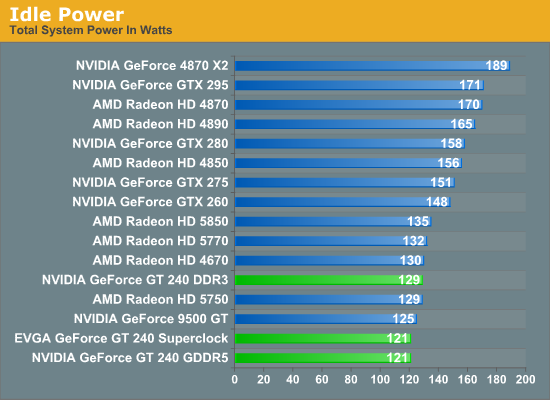
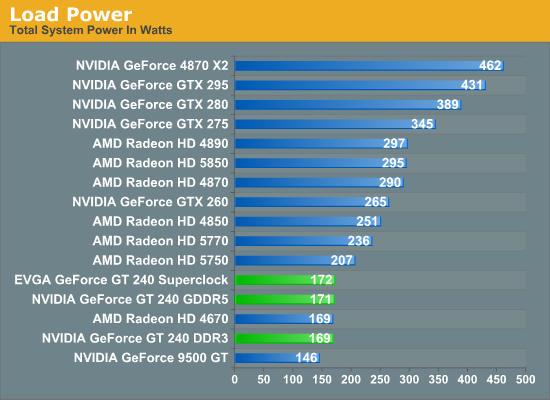
Due to some unrelated issues we don’t have the GT 220 in these charts, leaving the GDDR5 GT 240 as our least power-hungry card when it comes to idling. Unfortunately our DDR3 GT 240 refused to (or is simply not programmed to) idle, meaning that it comes in a good 8W higher than the GDDR5 versions of the cards. The lack of true idling for the DDR3 card will have some ramifications later.
Under load, these cards are still near the top of our charts. The only thing that’s significantly lower is the otherwise anemic 9500 GT while the Radeon 4670 is in a dead-heat. Between the GT 240 cards themselves, even with the different in RAM types, they’re all within 2W of each other. These would probably make fair HTPC cards, but the GT 220 should be a bit less power hungry and cooler.
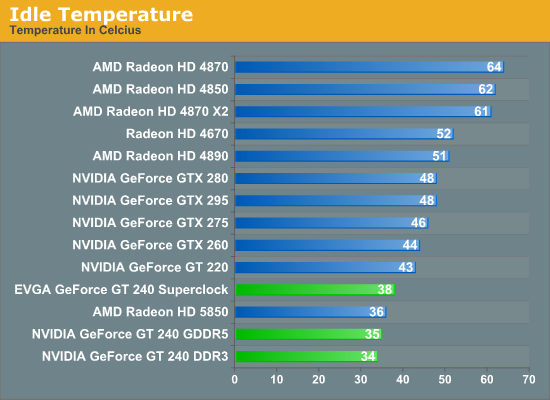
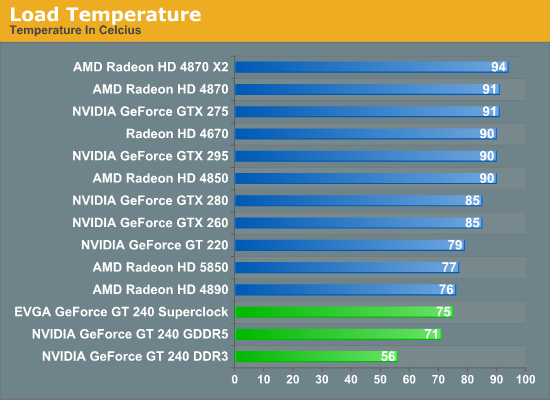
All of these cards push the limits of what’s practical for idle temperatures, although the Radeon 5850 is finally dethroned here by 2 of our GT 240 cards. The double-wide cooler on the Asus cards looks to be good for a couple more degrees than the single-wide cooler on the EVGA card is.
Load temperatures tell us a somewhat different story however. Ignoring the DDR3 card for a second, both the Asus and EVGA cards are quite cool. Our stock Asus card is some 8C cooler than our GT 220, and 19C cooler than the Radeon 4670. The EVGA card meanwhile is 4C cooler than the GT 220, and still 15C cooler than the 4670 in spite of the use of similar single-slot coolers. For what the GT 240 lacks in performance, it can certainly make up for in temperatures.
As for the DDR3 card, in spite of having the same cooler Asus has opted to run the fan at a higher speed. This makes it cooler, but as we’ll see it makes it louder too.
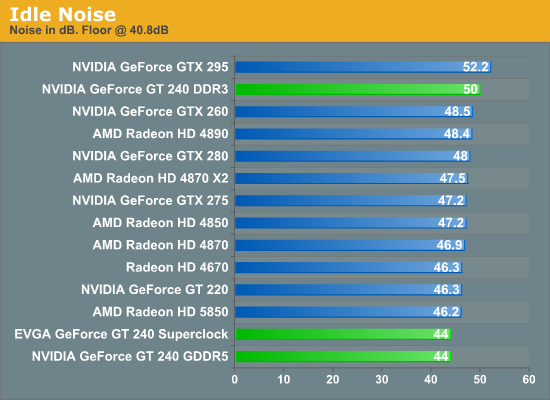
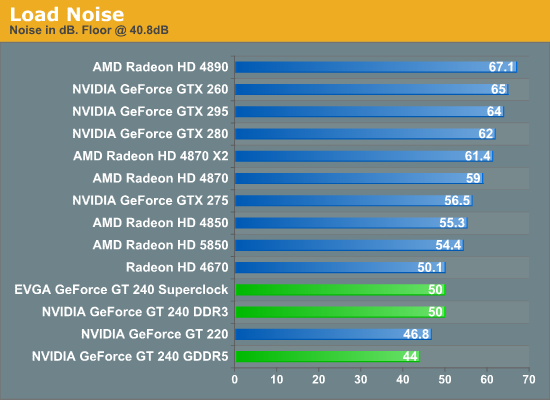
At idle, there’s not much of a story for the GDDR5 cards. They all run up against the ambient noise generated by the rest of the computer. Active and passively cooled cards are nearly indistinguishable at this point. The Asus DDR3 card however is quite distinguishable and is at the bottom of our charts. Its higher fan speeds means that it even idles at a pretty high speed, making it the second-loudest thing after the GTX 295.
It’s under load that the story takes a turn for the most interesting. At 50dB is the Asus DDR3 card and the EVGA card – the former continuing to use its high fan speeds, and the latter having to rev up to make up for its smaller single-slot cooler. Even at 50dB, these cards are quieter than everything besides the otherwise lower-powered GT 220.
Meanwhile down at 44dB is the Asus GDDR5 card, generating the same amount of noise as if it were idling. Based on these results, the card is for all practical purposes indistinguishable from a passively cooled card. Through the combination of a large fan and a large heatsink, the amount of noise the card generates falls below the ambient noise of the rest of the computer. The card is effectively silent.
Now we suspect that if we had a rig specifically for testing silent cards we would find a more notable difference, but in our i7 920 rig there is none to be found. The Asus GT 240 GDDR5 is the quietest actively cooled card we have tested to date, something we were not expecting to find on a GT 240 card. Also bear in mind that this the second-coolest card we have ever tested, falling behind only our overly loud DDR3 card. In the future, someone is probably going to make a very nice fully-passive card out of the GT 240 if all of this can be accomplished with the Asus cooler.










55 Comments
View All Comments
cweinheimer - Wednesday, January 6, 2010 - link
The review of the Asus 240 ddr5 card leads me to believe it could be a great HTPC card for HD content and some casual gaming. Does it support multichannel audio well enough?AznBoi36 - Wednesday, January 6, 2010 - link
AFAIK Nvidia cards doesn't pass audio over HDMI without a SPDIF pass-through, and as far as I can tell the GT240/220 doesn't have it.MadMan007 - Wednesday, January 6, 2010 - link
I might be fuzzy on remembering this but I could swear that some of the 'newer' NV cards (maybe the GT 210 and 220 which are similar to this card) can pass audio over the PCIe connection. So they still need an external sound source but not a connection.MadMan007 - Wednesday, January 6, 2010 - link
Ah yes here we go: http://www.anandtech.com/video/showdoc.aspx?i=3657...">http://www.anandtech.com/video/showdoc.aspx?i=3657... They support LPCM and lossy digital passthrough but not lossless digital passthrough. I assume that this GPU does as well.uibo - Wednesday, January 6, 2010 - link
Another rebadge? Nothing new here...klatscho - Thursday, January 7, 2010 - link
done already -> GTS260M/GTS360M;see here: http://www.semiaccurate.com/2010/01/03/nvidia-mobi...">http://www.semiaccurate.com/2010/01/03/nvidia-mobi...
wh3resmycar - Wednesday, January 6, 2010 - link
goodness gracious, a 4730 eats this card alive, for breakfast, lunch, dinner etc.Leyawiin - Wednesday, January 6, 2010 - link
An HD 4730 can't beat anything if you can't find one for sale. I dare you to."For the price of the GT 240 it performs too slowly, and for the performance of the GT 240 it costs too much. We cannot under any circumstances recommend buying a GT 240, there are simply better cards out there for the price."
Its faster than an HD 4670, uses less power than a "green" edition 9800 GT, runs cool and quiet and is physically small. A great many pre-built PCs with weak power supplies would benefit not to mention its uses for HTPCs.
KikassAssassin - Wednesday, January 6, 2010 - link
The funny thing about the vendors not wanting to send you cards knowing that they'd get a poor review is that this actually gives me more respect for Asus and EVGA.AznBoi36 - Wednesday, January 6, 2010 - link
Not really. ASUS is pretty big, so such a review probably won't change anything. EVGA well, we all know EVGA.The one that pulled out is probably a small, less well known partner. If that is the case, then it's understandable that a low performing product might hurt the brand value in the eyes of (average joe sixpack).